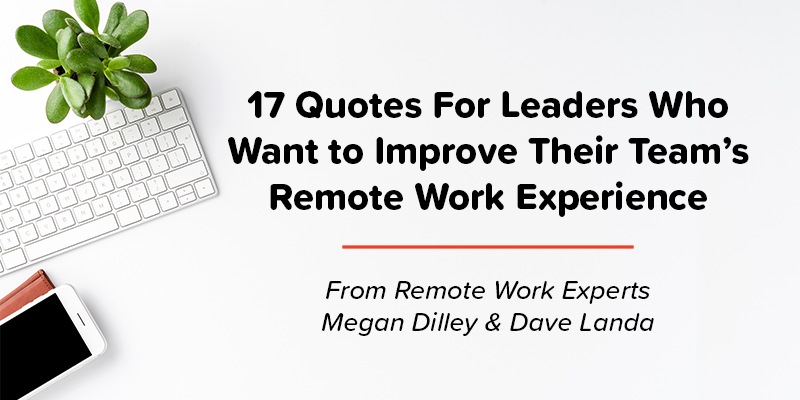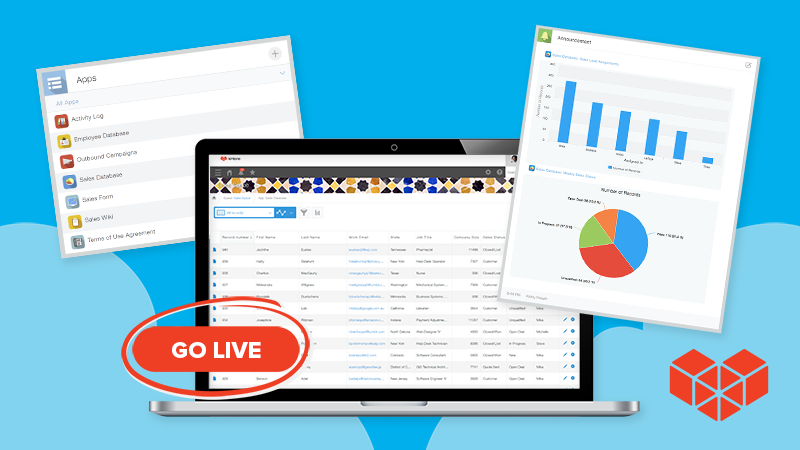Is remote work just bringing a laptop home?
Megan Dilley, President of Remote Work Association and remote work consultant, doesn’t think so. Remote work—especially sustainable remote work—requires re-adjusting our ideas about what productivity looks like, what’s required to create “culture,” and how technology plays a bigger role in both than we suspect, and more.
Dilley sat down with Kintone CEO Dave Landa, himself a remote work advocate with over four decades of experience, to explore what leaders need to know to make this remote work thing, well, work. Here are the top quotes you’ll want to read to get the most from their discussion.
You can watch their full dialogue here.
Jump to Quotes by Topic:
- Why Remote Work Requires You To Rethink Your Digital Operations
- Why A Good Company Culture Isn’t Built on Geographic Proximity
About Each of the Speakers

Megan Dilley: I've been working in San Francisco for the last seven years at startups in co-located spaces and offices. Traditional startup land. Where perks and benefits were king and culture was so important, but the idea of culture was all centered on being in the same location. I remember conversations around, "Oh, can we have a work from home day here or there?" But our leadership was really averse to that because there was this fear that by going home or not being together in the same place that we wouldn't be able to maintain culture.
The power of remote work is certainly what motivates me to be a remote work consultant...remote work runs deep for us [at Remote Work Association] and we're super passionate about helping others do remote work sustainably.

Dave Landa: My first experience was actually way back in the early '90s. I was a remote worker for a company called Silicon Valley Technology. I was based in Taipei, Taiwan. The company was a hardware manufacturer, basically manufacturing computer motherboards. And my remote work tools were a landline telephone and an old thermal roll printer, fax machine.
I was buying electronic components at the time for a computer motherboard manufacturing company. So I had to deal with things called bill of materials, which could be 20, 30 pages long, with 300 different electronic components with detailed specs in there. I would be awakened in the middle of the night when one of these BOMs was being faxed to me. And I would go and look at it and it would be about a 30 foot long roll of paper that I needed to cut into pieces, and then go down to the copier machine, because printers didn't copy back then, and re-create into a piece of paper that would actually last for more than a day.
So that's where I started my remote work experience. Since then I’ve done remote work on everything from email to phones to WebEx, and so on.
Creating Policies That Set Your Remote Employees Up for Success
Megan Dilley: The nature of working from home right now, especially for people who might have children at home who aren't going back to school or doing distance learning, is a whole different game. This is not normal work from home. This is not normal remote work. And eventually we will go back into or into some new normal that may involve mimics of childcare and working. But this is all really tough and new. And this isn't normal. So just remembering that I think is important.
Megan Dilley: [Organizing your company structure to be results-oriented first and foremost] is so imperative when working remote, because you're going to have people who need to work a few minutes here or there, then maybe be off for a few hours in the middle of the day to handle children or other duties. So be less focused on the time that people are sitting in their seat and they're on Slack and more focused on the expectation for outcomes.
Dave Landa: It's not about the 9:00 to 5:00. It's about just getting your work done when you can and everybody recognizing that different people have different challenges. We have a motto at Kintone: 100 different people have 100 different work styles. It’s a simple but really profound concept that emphasizes that focus on a culture built for people.
Megan Dilley: Have open conversations with your teams about their productivity. If you are a leader or a manager, make sure that you are doing everything you can to help people enhance their productivity. It's your responsibility to support and provide the structure people need to make remote work work for them.
Ask questions about their home office setup. You may learn that one of your team members is literally working from the edge of their bed. One, that's not safe for their ergonomics and physical health but they're not going to be as productive typing away in bed. Ask, how can we support you to get you a dedicated table and office setup? That kind of thing. Ask the questions that may seem obvious but that you might not be asking.
Megan Dilley: Understand that there's going to be distractions at home, obviously. There's distractions in an office, too. But help your team normalize distractions. Make it safe to have things happen. If a kid barges into the back of a video call, it's okay. If a dog's barking in the background, fine. These are all the things that we just have to adjust to and it’s important to help your team feel less anxiety around it, because it can be really anxiety provoking for somebody to say, "Oh my gosh, it's loud." Or, "Somebody's coming into this call." So those things make a big difference.
Dave Landa: For a lot of us at Kintone, this was our first time going remote for an extended period of time. Some folks took to it like a fish to water. Other folks are dealing with young children at the house. I've got a couple of teenagers myself. Just dealing with those different potential distractions and being flexible and sharing information is vital.
One of the first things we did when we went remote is we had everyone take photos of their setup at home. We could quickly see that some people who've been doing remote work for years had everything lined up perfectly. Other folks struggled. We had someone working out of a closet. One of the things we did to help our team adjust was create a stipend plan so that folks could purchase the things they needed, a comfortable chair, a good monitor, a good setup for a desk, whatever it was to get them more comfortable.
How to Address the Mental Health Challenges That Come with Remote Work
Megan Dilley: One thing companies can’t ignore is mental health. I think it’s imperative to create a safe space where people can share that they are feeling isolated. Or maybe they're not. Maybe they are an introvert and this has been the best thing for them, for example. So be vulnerable, ask the right questions, talk openly with your teams first and foremost. I think what remote work and this big remote experiment in 2020 has really taught us is that work is so much more human. Where working and home life are blending in a new way. It's like, are you working in your home office? Or are you living at work? We're all dealing with this changing meaning of home.
Megan Dilley: Let people know that it's okay to be burnt out. It's okay to feel isolated. Normalize those conversations. And recognize the signs of things like burnout, and help people recognize those signs for themselves. Because sometimes, you can think that it's just, "Oh, I've been working for two months without taking a day off, I must be reaching a state of burnout." But that's not necessarily the case. You can reach burnout on any given day. And you might start feeling apathy for your work, or you might start feeling just like you're overworking and you don't really know why. It's all of these signs and signals that could mean you just need to unplug. Whether it's take the rest of the afternoon off, take a day off tomorrow, take a week off.
Megan Dilley: Give yourself grace, give yourself permission to take some time for yourself.
Why Remote Work Requires You To Rethink Your Digital Operations
Dave Landa: The key concern and challenge for many companies has been managing operations. The actual workflows of operations, because most tools that manage these specific operations are standalone tools and they're separate from the communication part of things.
When people are in the office, there's a lot of context going back and forth in face-to-face communications. But when you're totally distributed and remote, you don't have those same opportunities to interact and decide on things and move things forward in that way. And so you end up doing it remotely either through email, or maybe on a call, or however it is. And so you lose that context for other team members because they can’t always see every email or be on every call.
I think that's been one of the biggest challenges for companies: how do you keep the communication data or the collaboration data with the operations data in your technology stack? Because once you lose that, you lose a lot of the context of decision making, you lose a lot of context of the data itself that might be residing in these operations solutions. And so I think that's a key piece. And I think that's been a struggle.
Megan Dilley: Companies think, we have so many solutions, we have so many applications. And now how do we make them all work together? And do we need all of these things and the additional silos in communication that each of those individual apps can create? It becomes a big problem and it's definitely something companies should be looking out for and proactively planning for and taking some time to evaluate their toolkit and their app stack.
Dave Landa: In order for a remote team to succeed, the most critical element a company needs is trust. And trust is developed through things like transparency and communication. Those are two critical things to build this trust. And tools are at the foundation of those values: you can’t build transparency and communication in a remote work setting without the right tools there to facilitate it. Companies need to have the policies and the practices that reinforce that communication and that transparency, plus activities where folks can interact with one another socially, to be able to build that trust.
Why A Good Company Culture Isn’t Built on Geographic Proximity
Megan Dilley: Culture is irrelevant to proximity.
Megan Dilley: Culture is about meaningful connection. But what we learn is that really, it goes back to the objective of why you're building culture in the first place, which is to help your employees and team members connect and to feel a sense of belonging to the work that they’re doing and the people that they're working with. So it's more about how people relate to one another within the context of the work that they're doing within the company.
So that really doesn't matter where you're located. Companies need to go one step deeper and ask themselves, "Okay, how do we achieve this meaningful connection if we're not in the same location? What’s truly important?" Maybe it's not about having a happy hour or being able to sit down and eat lunch together. So you have to think: how can we still forge meaningful connections? How can we do that in an asynchronous way to allow people more flexibility, so that they're not having to miss out on dinner with their family just to connect with you at a happy hour. I think it's remembering that culture should be built, first and foremost, based on your company's mission and values.
Dave Landa: We always did a monthly happy hour before COVID for the in-person people after our monthly meetings. And we didn't really include folks who weren't there.
Once we went remote, we tried to do this same process but digitally, and it was great initially; we had more involvement overall and the remote folks were into it. So we were like, "This is really great. So let's do it every week now." So we started doing it every week. But then we realized, you know what? This is cutting into people's dinner time. This is cutting into other people's schedules at different hours of the day. On the East Coast, it was late at night. So it's been an evolving thing. We want to try to get people together, we want to try to have an opportunity for people to share and meet socially, but we’re rethinking what works.
Dave Landa: You can’t mandate culture.
Dave Landa: You have to be intentional and you have to plan out how you want to develop culture. Your policies and practices and activities and tools will all have an impact on culture. And so you can either let it happen or you can be intentional about making it happen.
Next Steps: Learn How to Build a Better Remote Work Experience With Less Software
Want to know how to design and implement a strategy for reducing your software dependency and streamlining your workflows and conversation on the apps you have?
Check out our free in-depth webinar: How to Build a Better Remote Work Experience With Less Software. In 30-minutes we'll explore:
- Why most software setups teams are using aren’t ideal for remote work
- What you need to think about when evaluating your software setup
- How to build a software environment designed for remote work
We’re now facing a potential long-term remote work world. So why not plan for it?
About the Author
Michelle is the Content Marketing Specialist at Kintone. She is a content marketing expert with several years in content marketing. She moved to San Francisco in 2015 and has experience working in small businesses, non-profits, and video production firms. She graduated in 2012 with a dual degree in Film and English.











